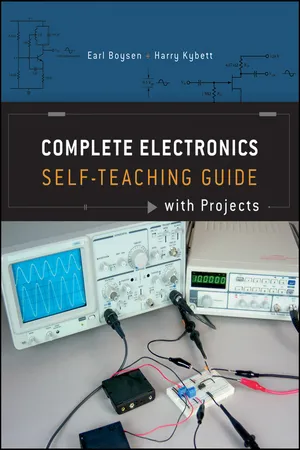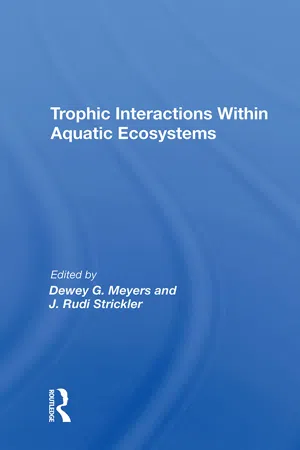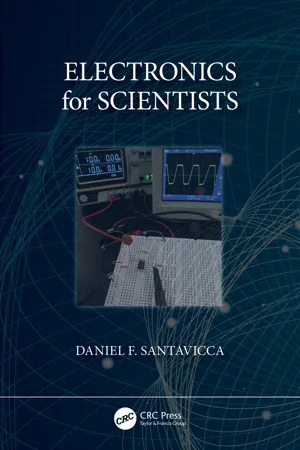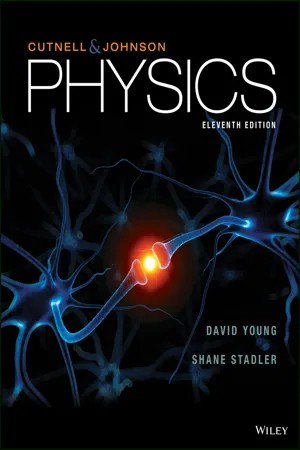Physics
RL Circuit
An RL circuit is a type of electrical circuit that contains a resistor (R) and an inductor (L). When a voltage is applied to the circuit, the inductor resists changes in current flow, causing the current to rise gradually. This behavior is characterized by a time constant, which determines how quickly the current reaches its maximum value.
Written by Perlego with AI-assistance
Related key terms
1 of 4
Related key terms
1 of 3
7 Key excerpts on "RL Circuit"
- eBook - ePub
- Clay Rawlins(Author)
- 2000(Publication Date)
- Newnes(Publisher)
CHAPTER 9RL Circuit Analysis
In Chapter 8 , you were introduced to a new circuit element, the inductor. In this chapter, the methods of analysis of series and parallel circuits containing resistors and inductors will be discussed .At the end of this chapter you should be able to:1. Determine the value of the inductive reactance, total impedance, total current, the component currents and voltages; real, reactive, and apparent power; and phase angle for series and parallel RL Circuits with various values of R, L, applied voltage, and frequency specified.2. Draw the impedance, voltage, current, and power phasor diagrams to show the phase relationships in series and parallel RL Circuits with certain circuit values specified. 3. Determine the circuit values of series and parallel RL Circuits by using Pythagorean theorem relationships for vectorially adding circuit quantities. 4. Determine phase angles of RL series and parallel circuits by using the tangent trigonometric function. 5. Determine the Q of a coil when given the inductance and internal resistance of the coil.INTRODUCTION
In the previous chapter, the inductor and its properties were introduced. However, like capacitive circuits, inductors are not usually the only component in circuits. A more common circuit is one in which inductors are combined in series, or in parallel with resistors. In this chapter you will learn techniques to solve problems for circuits containing a resistor and an inductor. You will learn how the phase relationship between voltage and current affect the analysis of such circuits. And you will learn how to compute the values for current, voltage, impedance, phase angle, and power for series and parallel circuits containing a resistor and inductor.SERIES RL Circuit
Phase Relationships in a Series RL CircuitA typical series RL Circuit is shown in Figure 9.1 - Earl Boysen, Harry Kybett(Authors)
- 2012(Publication Date)
- Wiley(Publisher)
Figure 7.2 , they have the same effect on electrical signals.Figure 7.2To simplify your calculations in the next few problems, you can assume that the small DC resistance of the inductor is much less than the resistance of the resistor R, and you can, therefore, ignore DC resistance in your calculations.When you apply an AC signal to the circuits in Figure 7.2 , both the inductor's and the capacitor's reactance value depends on the frequency.QuestionsA. What formula would you use to calculate the inductor's reactance? _____B. What formula would you use to calculate the capacitor's reactance? _____AnswersA. XL = 2πfLB.2 You can calculate the net reactance (X) of a capacitor and inductor in series by using the following formula:You can calculate the impedance of the RLC circuits shown in Figure 7.2 by using the following formula:In the formula, keep in mind that X2 is (XL – XC )2 .Calculate the net reactance and impedance for an RLC series circuit, such as those shown in Figure 7.2 , with the following values:1. f = 1 kHz2. L = 100 mH3. C = 1 μF4. R = 500 ohmsQuestions Follow these steps to calculate the following:A. Find XL : _____B. Find XC : _____C. Use X = XL – XC to find the net reactance: _____D. Use to find the impedance: _____AnswersA. XL = 628 ohmsB. XC = 160 ohmsC. X = 468 ohms (inductive)D. Z = 685 ohms3 Calculate the net reactance and impedance for an RLC series circuit, such as those shown in Figure 7.2 , using the following values:1. f = 100 Hz2. L = 0.5 H3. C = 5 μF4. R = 8 ohmsQuestions Follow the steps outlined in problem 2 to calculate the following parameters:A. XL- No longer available |Learn more
- Robert A. Pelcovits, Joshua Farkas(Authors)
- 2023(Publication Date)
- Barrons Educational Services(Publisher)
t = ∞.RL circuits are analogous to RC circuits, and it is useful to keep in mind the following parallels:RC circuitLR circuit analogTime Time Charge Current Current Voltage Time constant τ = RCTime constant τ = L/RGeneral Approach to Deriving Equations for RL Circuits
The following is the general approach used to derive all the formulas in this chapter. (As you will see, it is quite similar to the approach we used to solve RC circuits.)STEP 1 Write a Kirchhoff’s loop equation for your circuit. Here’s how to treat an inductor in your Kirchhoff’s loop equation:a.The magnitude of the voltage is given by Faraday’s law:b.The sign of the voltage is given by Lenz’s law. The sign of the voltage across an inductor always serves to oppose the change in current in the circuit (thereby opposing the change in magnetic flux).STEP 2 Now you should have a differential equation involving various constants, I, and t. You can separate variables and perform an indefinite integral.STEP 3 Use the initial conditions to eliminate the constant of integration. (The value of the current at very long times can serve as verification that your answer is correct.)Example 16.2 Current Growth Through an InductorAt time t = 0, you attach a battery of voltage V to a circuit containing a resistor (of resistance R) and an inductor (of inductance L). What is the current as a function of time?STEP 1 Start with Kirchhoff’s law equation (Figure 16.1 ):Figure 16.1Note the sign of the voltage across the inductor. Because the inductor is pushing the current in the opposite direction compared to the battery (in order to oppose the increase in current), the voltage across the inductor must have a sign opposite that of the battery. The quantity L(dI/dt) is positive because current is increasing, so we add a negative sign to make the expression negative, −L(dI/dt - eBook - ePub
- Ahmad Hemami(Author)
- 2017(Publication Date)
- CRC Press(Publisher)
- Voltage across the inductor is equal to the voltage across the capacitor.
- Voltage across the resistor is equal to the applied voltage (according to Equation 8.26 ).
- Impedance of the circuit has its lowest value and is equal to R (see Equation 8.25 ).
- Circuit current assumes its maximum value because the impedance is minimum.
- Power factor for the circuit becomes equal to 1, and the phase angle is zero.
- Apparent power has its lowest value and becomes equal to the active power because the power factor is 1.
8.13.2 Resonance in Parallel Circuits
Similar to the series circuits, when resonance occurs in a parallel RLC circuit the resonance condition (Equation 8.31 ) leads to other relationships or properties:- Current in the inductor is equal to the current in the capacitor.
- Current in the resistor is equal to the total circuit current (according to Equation 8.28 ).
- Impedance of the circuit has its highest value and is equal to R (see Equation 8.29 ).
- Circuit current assumes its minimum value because the impedance has the highest value.
- Power factor for the circuit becomes equal to 1, and the phase angle is zero.
- Apparent power has its lowest value and becomes equal to the active power because the power factor is 1.
Figure 8.46 Principle of induction heater and induction cooker.When resonance occurs in a parallel RLC circuit, a local current circulates between the inductor and the capacitor. This current can be very high, while the circuit current as seen from the source can be low. This phenomenon is used in induction heaters (in industry for heating metals when necessary, e.g., heating bearings for mounting or dismounting) and in induction cookers (for domestic use). In such an application a high current is flowing through an inductor, whereas the current provided by the power line is small. This means that the rating of the wires and breakers are much smaller than the current in the inductor. The current in the inductor creates (induces) local currents in the piece to be warmed, without even touching it. In the case of an induction cooker the body of the cooking pan becomes hot owing to local currents created by induction. This is shown in Figure 8.46 - eBook - ePub
- Daniel Santavicca(Author)
- 2023(Publication Date)
- CRC Press(Publisher)
2 Linear AC CircuitsDOI: 10.1201/9781003408499-2AC stands for alternating current and refers to circuits whose currents and voltages are not constant in time. When we talk about AC circuits, we often assume that the currents and voltages oscillate as sinusoidal functions of time, although this is not always the case. A linear AC circuit component is one whose properties do not depend on the amplitude of the current through the component. In this chapter, we will assume that our components are linear. This assumption will be relaxed in later chapters.2.1 CAPACITANCE AND INDUCTANCE
If we have two oppositely-charged conductors that are not in contact and that each contain a net charge magnitude Q, there will be an electric field pointing from the positively-charged conductor to the negatively charged conductor. If we integrate the electric field along some path that goes from the surface of one conductor to the surface of the other conductor, we will find the voltage V between the two. We find that Q and V are linearly proportional, and so we introduce a constant of proportionality that we call the capacitance C:This is our defining equation for capacitance, in the same way, that Ohm's law is our defining equation for resistance. Capacitance has SI units of farads (F).Q = C V(2.1)Equation 2.1 is true for any capacitor, regardless of geometry. For a particular geometry known as a parallel-plate capacitor, we can arrive at a convenient expression for the capacitance in terms of the physical properties of the capacitor. A parallel plate capacitor has two identical metal plates, each with surface area A, separated by a uniform distance d. Assuming that d - eBook - ePub
MSP430-based Robot Applications
A Guide to Developing Embedded Systems
- Dan Harres(Author)
- 2013(Publication Date)
- Newnes(Publisher)
Figure 3.20 ).Figure 3.20 Resistor voltage for the example resistor/inductor circuit.Comparing Figures 3.15 and 3.20 shows that, for these particular values of resistor and inductor, the response of this circuit is identical to the resistor/capacitor circuit analyzed earlier. As with the resistor/capacitor circuit, this circuit has an exact response that can be derived using calculus and is given by:(3.28)In both the resistor/inductor circuit and the resistor/inductor circuit, the steady-state value is 5 V.Inductors in series and parallel
Series and parallel combinations of inductors behave in the same way as series and parallel combinations of resistors. That is, series inductors add and parallel inductors are mathematically combined in the same manner as was shown for resistors in Figure 3.9 .Electric and magnetic fields
The subject of electromagnetic fields is an important one in electrical engineering, but it’s one that we can almost get by without talking about in this book. However, when we discuss motors in the next chapter, some basic understanding of magnetic fields will be needed.There is, of course, an electric field as well as a magnetic field. For example, a battery connected to the parallel-plate capacitor of Figure 3.11 creates charge on each of the plates, which, in turn, induces an electric field, E . Figure 3.21 shows such a situation.Figure 3.21 Parallel-plate capacitor charged by battery.The electric field can easily be calculated for this. However, an understanding of electric fields beyond what you’ve encountered in high-school physics isn’t required to build the robot project of this book, so we’ll leave the topic of electric fields and venture on to magnetic fields. - eBook - ePub
- John D. Cutnell, Kenneth W. Johnson, David Young, Shane Stadler(Authors)
- 2018(Publication Date)
- Wiley(Publisher)
Example 5 illustrates how to gain insight into more complicated circuits using the limiting behaviors of capacitors and inductors.CONCEPTUAL EXAMPLE 5 | The Limiting Behavior of Capacitors and Inductors
shows two circuits. The rms voltage of the generator is the same in each case. The values of the resistance R, the capacitance C, and the inductance L in these circuits are the same. The frequency of the ac generator is very nearly zero. In which circuit does the generator supply more rms current, (a) circuit I or (b) circuit II?Figure 23.13aFIGURE 23.13(a) These circuits are discussed in the limit of very small or low frequency in Conceptual Example 5 . (b) For a frequency very near zero, the circuits in part a behave as if they were as shown here.Reasoning
According to Equation 23.6 , the rms current is given byIrms = Vrms /Z. However, the impedance Z cannot be obtained from Equation 23.7 , since the circuits inare not series RCL circuits. Since Vrms is the same in each case, the greater current is delivered to the circuit with the smaller impedance Z. In the limit of very small frequencies, the capacitors have very large impedances and, thus, allow very little current to flow through them. In essence, the capacitors behave as if they were cut out of the circuit, leaving gaps in the connecting wires. On the other hand, in the limit of very small frequencies, the inductors have very small impedances and behave as if they were replaced by wires with zero resistance.Figure 23.13aFigure 23.13b
Index pages curate the most relevant extracts from our library of academic textbooks. They’ve been created using an in-house natural language model (NLM), each adding context and meaning to key research topics.
Explore more topic indexes
Explore more topic indexes
1 of 6
Explore more topic indexes
1 of 4






